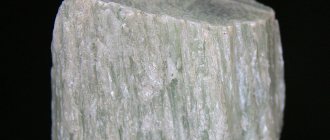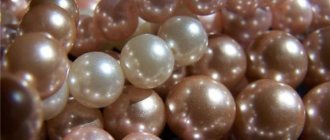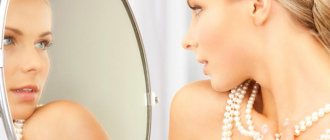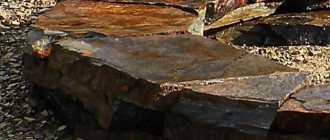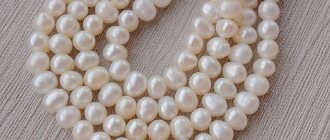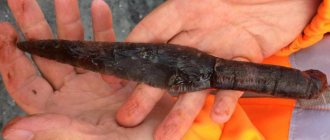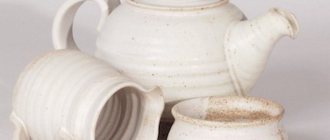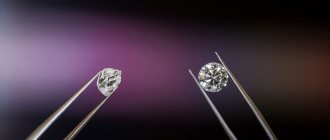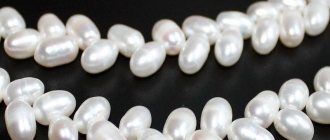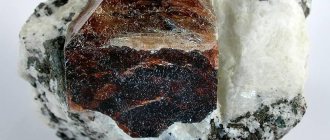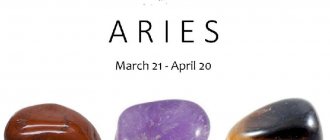| Stone type | Precious, semi-precious |
| Prevalence (Deposits) | Mexico, Panama, India, Tahiti, Sri Lanka, Japan, etc. |
| Varieties | Acoya, Baroque, Mabe, Mallorca, Oceanic, Freshwater, Tahiti, South Sea |
| Transparency | Translucent, opaque |
| Shine | Pearl |
| Mohs hardness scale | 3—4 |
| Chemical composition | CaCO3 |
| Color | White, blue, yellow, gold, pink, gray, black |
| Owner's color type | Spring, winter, autumn |
| Owner's temperament | Melancholic, Sanguine |
| Names | Andrey, Boris, Valentina, Galina, Eva, Evgeny, Evdokia, Inna, Irina, Claudia, Lilia, Margarita, Nadezhda, Oleg, Rosa, Sergey, Sofia, Elina, Yuliana |
| Zodiac sign | Libra, Cancer, Pisces |
| Date of Birth | from June 22 to July 22 from September 23 to October 23 from February 19 to March 20 |
| Chinese horoscope | Rabbit, horse, dog |
| Element | Water, Air |
| Planet | Neptune |
| Day of the week | Monday |
| Month | June, July, November, February |
| Season | Winter, summer, autumn |
| Numerology vibration | 2, 6, 7 |
| Chakra | Vishuddha, Sahasrara |
| What stones is it compatible with? | Aventurine, aquamarine, amethyst, turquoise, diamond, heliodor, heliotrope, garnet, emerald, moonstone, opal, rose quartz, ruby, chrysoprase, zircon, jasper |
| What stones is it not compatible with? | Beryl, malachite, sardonyx |
| Therapeutic effect (problems) | Blood pressure, vision, immunity, nervous disorders, memory and mental abilities |
| Therapeutic effect (on organs) | Organs of the gastrointestinal tract |
| Magic properties | Spiritual development, deception, strengthening relationships, black magic |
When most people hear the word “pearl,” they imagine an ideally shaped white mother-of-pearl ball. However, nature is beautiful precisely in its diversity, which is why precious “tears” of sea shells have the most bizarre shapes, sizes and colors. Baroque pearls are clear proof of this. This type of mineral is valued no less than the spherical standard, and jewelry made from it is unique and inimitable precisely because of its unusual and rare shape.
History of appearance
The formation of a pearl in natural conditions sometimes takes several decades. Artificial cultivation significantly reduces the time frame. In this case, the process of mineral formation is identical to the action occurring under the influence of natural factors with the only difference being the artificial placement of the core of the future pearl into the shell of a mollusk.
The oyster's response is to produce nacre, which begins to cover the base in a thin layer. The more layers, the richer and purer the shade of natural “sea stone”. If the color of a pearl depends on the type of mollusk, then the shape depends on the location of the nucleus, the ribbing of the shell walls and the presence of foreign bodies.
Baroque pearls are most often formed when they develop in the area of the valves or when the mineral comes into contact with the inner walls of the shell. The larger the contact area, the more unusual the shape of the “final product”. Pearls of this type can be cultivated in both sea and fresh water conditions.
This variety owes its name to the style of the same name. Barocco means baroque in Italian and unpolished in Portuguese. Raw pearls of unusual shape, but amazing texture and shine, quickly gained popularity in high society.
Earrings, pearl necklaces and pendants set in precious metals were made from pear-shaped and teardrop-shaped stones. Each such product was unique, and the history of the most famous of them is closely connected with the fate of great personalities: Cleopatra, King Philip II of Spain, Elizabeth Taylor.
Be sure to watch: Heliotis - a magic stone: fact or fiction?
Comparison with the present
Bracelets, earrings, beads from Mallorca - how are they different from pearls of natural origin? The production technology allows us to accurately replicate the composition and characteristics of natural pearls. They also consist of calcium carbonate and are covered with natural mother-of-pearl, isolated from the shells of mollusks and fish scales. Hardness, density, fracture correspond to natural specimens.
Kinds
Jewelers distinguish several types of baroque pearls. Most of the names are related to the geography of materela cultivation.
Kasumi
This variety belongs to the freshwater pearls and is grown in the upper region of the Japanese lake Kasumi-ga-ura, from which it got its name. The producer is a hybrid obtained by crossing a lake oyster and a bivalve mollusk imported from China.
Most of the resulting minerals are 10-12 mm in size and range in shades from milky white to dark purple. The most valuable pearls are those of deep purple color. The surface of each “tear” is grooved with a bright shine, which is provided by an impressive layer of mother-of-pearl. Kasumi pearls are not processed and are valued on the world market, partly due to their limited production (no more than 5 thousand pieces per year).
Interesting! An analogue called “Kasumi-like” is produced in China and Australia. Its cost is lower than the original, and the differences are minimal.
Mabe
The main difference between this type is the blister form. Manufacturers achieve such contours by implanting the core into the shell of a sea shell. During the formation process, the mineral grows to the shell and is removed by cutting out a section of its valve. The grain size varies from 8 to 15 mm, colors - from cream to gold, green and iridescent blue. The main pearl farms are located in the Philippines, Indonesia and Australia.
Keshi
Keshi pearls are a by-product of the cultivation of other types of pearls. During the harvest process, producers often discover “cotton-like” nacre formations in shellfish. The peculiarity of this species is that humans practically do not participate in its formation.
Keshi minerals are attractive due to their unique shimmer and shine. The color palette is very diverse. The most valuable pearls on the market are lavender and pistachio colored pearls. The grains are often used as petals to create original flowers for brooches and pendants.
Keshi pearls are nuclear-free pearls consisting of 100% mother-of-pearl. The price of grains depends not only on weight, but also on the natural shade.
Biwa
The Biwa variety is another type of nuclear-free freshwater pearl. Farms for its cultivation are located on the lake of the same name near Kyoto. The technology for their production is called “all-nacre Biwa pearls”. A distinctive feature of the grains is their oblong, uneven shape.
Biwa are large pearls, reaching 15-16 mm in diameter. It also has a range of expressive shades from cream to blue-green. Grains of this type are characterized by a high degree of luster (reflection of light from the surface). The price of these pearls has increased significantly over the past few decades, due to the reduction in the places where they are cultivated.
Published by AllTime.ru online store Tuesday, March 26, 2021
Souffle
The Souffle pearls were given their name not in France, the birthplace of the dessert of the same name, but in America. Author: Jack Lynch, renowned pearl expert. The name is translated from French as “to inflate”, which quite well reflects the structural feature of the mineral. It is hollow and irregular in shape.
Its production technology makes it possible to add a foreign material that absorbs water to a developed pearl sac. As a result, the core expands, the grain enlarges and becomes overgrown with an increasingly thick layer of nacre. The diameter of pearls can be 30-35 mm. These are the largest minerals of all types of freshwater pearls.
Be sure to check out: What is cultured pearl, its properties and differences from natural and artificial
Souffle grains are characterized not only by their large size, but also by their unique color with many iridescences. The palette of shades is varied, but the most common are cream, pink and greenish-blue tones.
Magical and healing properties
Like many natural materials, pearls have a number of healing properties. And its long history and non-standard shape contributed to the emergence of many legends and superstitions around this mineral.
According to traditional medicine experts, wearing baroque pearls helps:
- relieve migraines and headaches;
- normalize hormonal balance;
- alleviate the patient’s condition with damage to the respiratory system;
- fight stress and depression;
- improve the functioning of the gastrointestinal tract system.
Interesting! Pearl powder is used to stop bleeding, disinfection, allergic reactions and treatment of skin diseases. Rinsing with pearl water will improve the condition of your hair and skin and get rid of acne.
Speaking of magical properties, it is believed that this mineral has strong energy. Decoration made from it will be an ideal gift for a person involved in business. Talismans with this stone attract well-being and prosperity.
You should not give pearls to weak-willed and insecure people. It is also not recommended to present it to athletes, actors or travelers. There is an opinion that pearl products can “unbalance” the energy of people of these professions.
“Baroque #pearls (#baroque) what is it?”
- you ask. The answer is very simple. All pearls that are irregularly shaped are… Published by Maysaku Wednesday, December 13, 2021
People born under the signs of Cancer, Pisces and Libra will appreciate jewelry made from baroque pearls.
It is believed that light pearls can calm the nervous system, while black pearls can give strength and increase performance.
Do you like the whimsical shapes of baroque pearls?
Very Not particularly
How to spot a fake
Despite the relatively low cost of baroque pearls, fakes can often be found on the jewelry market.
You can distinguish natural stone from costume jewelry by the following characteristics:
- On non-original stones, the glue line is visible. This imitates the irregular shape of the beads.
- A dull shine and visible particles on the surface of the stone indicate artificial origin. This is revealed when the glass base is coated with fish scale paint.
- When two stones are gently rubbed against each other, a characteristic pearlescent powder is released.
- Under the influence of ultraviolet light, the baroque gem has a bluish glow. Counterfeits do not have this effect.
- If you place a bead in vinegar, it will instantly dissolve. The glass imitation will not change in any way. The test is reliable, but you risk losing the stone if it is original.
- Glass and plastic are sensitive to high temperatures. If you throw jewelry into a fire, it will instantly melt. A natural mineral may remain unchanged for several minutes.
Despite the relative simplicity of the tests, only a professional can determine a high-quality imitation.
See how to distinguish a real stone from a fake one:
Rules of care
You can preserve the appearance of jewelry for a long time only with proper care and storage.
Natural pearls are a fairly soft material. It is easily scratched and abraded if the beads rub against each other. To preserve the shape and color of pearls for as long as possible, you must remember the following:
- all jewelry should be stored in separate cases or compartments of the jewelry box, flattened;
- the inside of the boxes should be lined with soft fabric;
- You should not wear pearls while playing sports, swimming, or during active physical activity;
- Products made from this material must not be wiped with alcohol or oils (including essential oils);
- Do not apply cosmetics or perfume (loose powder, perfume) over jewelry.
This mineral of organic origin requires more careful care than jewelry made from an artificial analogue. However, at the same time, it is a more profitable financial investment, which only increases in value over time.
Interesting Facts
You can hear a lot of interesting things about this mineral (in the phrase baroque pearl the emphasis is on the second syllable).
- The more time it stays on the body, the more beneficial it is. However, you need to know that it should be put on last and taken off first.
- Before removing the jewelry to its storage location, the beads must be thoroughly wiped with a warm, damp cloth in order to remove negative energy.
- Pearls need “active” breathing. It is advisable to re-bandage the necklace every 2-3 years, and store it separately from perfumes, household chemicals, and food.
- The stone does not like dry hot air.
Price
The cost of pearl jewelry depends on many factors: type, size, weight, shade, shape and even manufacturer. Thus, Kasumi baroque pearls cost at least $200 per unit, while other irregularly shaped pearls can be priced an order of magnitude lower.
The shade of the pearl also plays an important role in determining the final price. The darkest shades of purple, violet and cobalt tend to be the most expensive.
Baroque pearls are used by jewelers all over the world to make the most original pendants, earrings and rings. Its drop-shaped shapes look very harmonious as pendants framed with smaller gemstones. Because of its unusual shape, it is the Baroque pearl that often becomes the center of the entire jewelry composition.
The price for such products varies from 1000 to 2500-3000 dollars. Affects the cost and material of the frame. The simplest silver frame will not greatly increase the price tag, but gold or platinum inlaid with precious stones will make the jewelry truly elite.
The most famous Baroque pearls
One of the most famous Baroque pearls was found in the 19th century. Her owner, Henry Hope, was a wealthy stone collector.
Officially, the mineral is considered one of the largest in the world. The weight of the pearl is 90 grams. The stone has an irregular teardrop shape and uneven color. The upper part has a silvery-white color that turns into dark olive.
The pearl “La Peregrina” also became famous. It is teardrop-shaped and white in color. This jewel was once owned by King Philip II and Elizabeth Taylor. At the moment, the pearl is in the possession of an unknown collector, to whom it was sold at auction.
Are baroque pearls counterfeited?
The popularity of Baroque pearls also affected the frequency of their counterfeits. Increasingly, scammers are trying to pass off fake mother-of-pearl beads as a natural product.
To avoid becoming a victim of such deception, you need to take a close look at the appearance and literally feel the product.
Interesting! The surface of real pearls cannot be smooth. There will definitely be some roughness and small scratches on it. Often, scammers create baroque pearls from two parts. Upon careful inspection, you can see the gluing line.
Natural pearls are always heavier than artificial pearls (with the exception of the Souffle type). The chandelier surface of natural pearls is more intense.
https://youtu.be/V8hPPAUiQBA
Who can wear pearl jewelry with Mallorca?
Jewelry with high-quality imitation of natural mother-of-pearl beads is acceptable for everyone. There are no restrictions due to the artificial origin of the material, so the decoration does not have any magical or medicinal properties. This fact prevents the use of mother-of-pearl pearls as talismans and amulets that attract good luck. Artificial stone is safe and suitable for all signs of the Zodiac circle without exception. The lack of specific qualities makes beads a universal gift for any woman.
Main conclusions
The ideal spherical shape is not the only form in which pearls appear. It is the diversity of its contours and shades that attracts jewelers and fans of this natural material.
- Baroque pearls got their name thanks to the style of the same name, which welcomes the uniqueness and originality of things.
- Most often, manufacturers name species by the location of the pearl farms where they are grown
- Like most varieties of pearls, baroque pearls are credited with extraordinary healing and magical properties.
- It is actively used in traditional medicine in Asian countries, especially China.
- In order to identify a fake, you need to carefully examine and “palp” the beads.
An original design created by nature itself – that’s what baroque pearls are. Its finished forms allow you to create exclusive jewelry that is valued on the market no less than products made from classic round beads.
